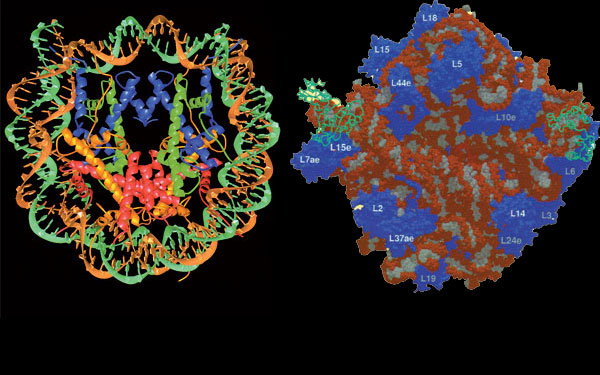Nothing was known in Darwin's time about the complex structure of the cell.
The theory of evolution maintains that life on Earth came about as the result of chance and emerged by itself from natural conditions. This theory is not a scientific law or a proven fact. Underneath its scientific façade it is a materialist worldview that Darwinists are trying to impose on society. The bases of this theory, which has been disproved by science in every field, are suggestions and propaganda methods consisting of deceptions, falsehood, contradiction, cheating, and sleight of hand.
The theory of evolution was put forward as an imaginary hypothesis in the context of the primitive scientific understanding of the nineteenth century, and to this day it has not been backed up by any scientific discovery or experiment. On the contrary, all the methods employed to confirm the theory have merely proven its invalidity.
However, even today many people think that the theory is a proven fact, like the force of gravity or the law of buoyancy. Because, as stated at the beginning, the true nature of the theory of evolution is very different from what is usually supposed. For this reason, some people do not know what rotten foundations this theory has, how it is disproved by science at every turn, and how evolutionists are trying to keep it alive in its death throes. Evolutionists have no other support than unconfirmed hypotheses, biased and unrealistic observations, and imaginary drawings, methods of psychological suggestion, countless falsehoods, and sleight-of-hand techniques.
Today, such branches of science as paleontology, genetics, biochemistry, and molecular biology have proven that it is quite impossible for life to come about as a result of chance and to emerge by itself from natural conditions. The living cell, it is commonly agreed by the world of science, is the most complex structure that mankind has so far encountered. Modern science has revealed that just one living cell has a much more complex structure and mutually interconnected complicated systems than a large city. Such a complex structure can only function if all its separate parts emerge at the same time and in full working order. Otherwise, it will serve no purpose, and will fall apart over time and disappear. We cannot expect that its parts developed by chance over millions of years as claimed by the theory of evolution. For that reason, the complex design in just one cell clearly shows that God created life. (For more details, see Harun Yahya, The Miracle in the Cell)
However, those who defend materialist philosophy do not want to accept the fact of creation for various ideological reasons. That is because the existence and spread of societies living in the light of that beautiful morality that true religion offers to man by means of God's commands and prohibitions is not in these materialists' interests. Masses devoid of any spiritual and moral values suit these people far better, since they can manipulate them for their own worldly interests. For this reason, they try to impose the theory of evolution, which encourages the lie that mankind was not created but rather emerged by chance and evolved from animals, and to keep it alive at whatever costs. Despite all the clear scientific proof that destroys the theory of evolution and confirms the fact of creation, they abandon all reason and logic and defend this nonsense at every available opportunity.
 Nothing was known in Darwin's time about the complex structure of the cell. |
|---|
It has actually been proved that it is impossible for the first living cell, or even just one of the millions of protein molecules in that cell, to have come about by chance. This has been demonstrated not only by experiments and observations, but also by mathematical calculations of probability. In other words, evolution collapses at the very first step: that of explaining the emergence of the first living cell.
Not only could the cell, the smallest unit of life, never have come about by chance in the primitive and uncontrolled conditions in the early days of the Earth, as evolutionists would have us believe, it cannot even be synthesized in the most advanced laboratories of the twentieth century. Amino acids, the building blocks of the proteins that make up the living cell, cannot of themselves build such organelles in the cell as mitochondria, ribosomes, cell membranes, or the endoplasmic reticulum, let alone a whole cell. For this reason, the claim that evolution brought about the first cell by chance remains the product of a fantasy based entirely on imagination.
The living cell, which still harbours many secrets that have not been explained, is one of the major difficulties facing the theory of evolution.

Examples of the complex structures in cells: Right, a ribosome where the protein synthesis takes place in the cell. Left, a "nucleosome" which packages DNA units in the chromosome. The cell contains many very complex structures and systems such as these, and even more complex ones. The realisation that these complex structures, discovered by technology as it advanced, could not have come about by chance has placed evolutionists in a dilemma they can never solve.
Another terrible dilemma from the point of view of evolution is the DNA molecule in the nucleus of the living cell, a coding system with 3.5 billion units containing all the details of life. DNA was first discovered using X-ray crystallography in the late 1940s and early 1950s, and is a giant molecule with a superb plan and design.
 Francis Crick |
|---|
For many years, Francis Crick, a Nobel-prize laureate, believed in the theory of molecular evolution, but eventually even he had to admit to himself that such a complex molecule could not have emerged spontaneously by chance, as the result of an evolutionary process:
An honest man, armed with all the knowledge available to us now, could only state that, in some sense, the origin of life appears at the moment to be almost a miracle.1
The Turkish evolutionist Professor Ali Demirsoy was forced to make the following confession on the issue:
In fact, the probability of the formation of a protein and a nucleic acid (DNA-RNA) is a probability way beyond estimating. Furthermore, the chance of the emergence of a certain protein chain is so slight as to be called astronomic. 2
 From the time Darwin's theory came to dominate science to the present day, paleontology has considered the theory its very basis. Despite this, however, excavations in many parts of the world have produced results that conflict with the theory instead of backing it up. Fossils show that different living groups emerged suddenly with all their features intact—in other words that they were created. |
|---|
Homer Jacobson, Professor Emeritus of Chemistry, makes the following admission regarding how impossible it is for life to have come about by chance:
Directions for the reproduction of plans, for energy and the extraction of parts from the current environment, for the growth sequence, and for the effector mechanism translating instructions into growth—all had to be simultaneously present at that moment [when life began]. This combination of events has seemed an incredibly unlikely happenstance… 3
The fossil record represents another crushing defeat for the theory of evolution. Among all the fossils discovered over the years, there is not one trace of the intermediate forms that would be necessary if living things were to have evolved stage by stage from simple species to more complex ones, as the theory of evolution claims. If such creatures had really existed, there would have been millions, even billions, of them. More importantly, the remains of these creatures should be present in the fossil record. If these intermediate forms had ever really existed, their numbers would be even greater than the number of animal species we know today, and everywhere the world should be full of their fossil remains. Evolutionists look for these intermediate forms in all the feverish fossil research that has been carried out since the nineteenth century. However, there has been no trace of these intermediate forms, despite all the eager searching for the last 150 years.
In short, the fossil record shows that living species emerged suddenly and perfectly formed, not by following a process from primitive forms to advanced ones as evolution claims.
Evolutionists have tried very hard to find evidence for their theory or so, but have actually proved by their own hand that no evolutionary process could have been possible. In conclusion, modern science reveals the following indisputable fact: Living things did not emerge as the result of blind chance, but God created them.
1 Francis Crick, Life Itself: It's Origin and Nature, New York, Simon & Schuster, 1981, s. 88
2 Ali Demirsoy, Kalıtım ve Evrim, Ankara: Meteksan Yayınları, 1984, s. 39
3 Homer Jacobson, "Information, Reproduction and the Origin of Life", American Scientist, Ocak 1955, s. 121